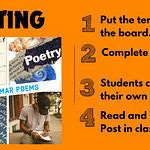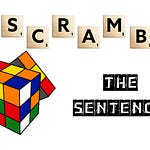The above video exemplifies a feeling I think we’ve all experienced as young students sitting in class, sitting, sitting and sitting and just wishing for it to be over. (the video on our Youtube Channel is part of an excellent material - Famous Poems To Discuss)
How often in your classes is the content highly interesting, something students want, yearn to learn? Research shows this is the most important piece in the learning puzzle yet most of our classes are filled with time spent studying topics which students haven’t any interest in or compelling reason to be interested in. We all know at the bottom of our hearts, “You can push a student into a classroom but you can’t make him/her drink.” The student needs interest and it is this “buzz” inside the head that matters for attaining educational outcomes.
Too much of what a teacher does is “force feeding”. Now, some of this can be necessary and good. Priming the pump or just teaching students discipline or when you need to cover the basics of some topic. However, when it comes for those things learned as a skill, by doing, not remembering (procedural not declarative knowledge) - it can really work against student learning.
Imagine a basketball lesson for gym class and the teacher talked, explained for 30 minutes and you only got to play for 10 minutes. How effective would those 30 minutes of teaching how to play the game with diagrams and gestures really be?
Many studies have reached the same general conclusion about the disproportionate impact of interest. In one experiment, fourth graders’ comprehension turned out to be so much higher when the passages they were assigned dealt with topics that interested them — suddenly, the kids were testing well above their supposed reading level — that the researchers ended their report by asking why teachers and researchers tend to be so “concern[ed] with difficulty when interest is so obviously a factor in comprehension.” - Thomas H. Estes and Joseph L. Vaughan, Jr., “Reading Interest and Comprehension: Implications,” The Reading Teacher 27 (1973): 149-52
Now, to begin, we must make a clear distinction between “fun” and “interesting”. Too often, we don’t make the correct distinction. Fun can help learning but interest will make it happen. Fun is hit and miss, interest is on target. Entertainment leads, interest drinks - is one way to put it. Try to make your classes more interesting.
Krashen wrote a very small paper years ago (I wrote about it at the time here) that has always fascinated me. The Din Inside The Head. He has always cheerlead the fact that for learning to occur, students needed to WANT to understand the messages they received. No ego, no big desire, no learning. Krashen associated this “din inside the head” as being a sign of language acquisition happening and of student learning. We need more “dinging” and less dozzing in our students’ heads.
But how do you do this given the dry textbooks that abound and the page turning and worksheets that keep students half asleep?
Here are 5 key things that teachers can do to keep interest high and thus, student learning on fire.
CI - comprehensible input. It’s central to student interest. Students can’t maintain interest if there is too much language they don’t understand. After a few minutes, they’ll give up their attention and turn off.
Hooks. If possible, lessons need a hook. A way to catch the spirit and imagination of students and activate their interest in a lesson. I’ve often used tricks, riddles, illusions or even really interesting videos to set fire to student motivation and interest.
Needs Analysis. Spend time finding out what interests your students, what they like, love, do, spend time at … Somehow add these to lessons and personalize their learning, giving them the freedom to learn through the things they are interested in. Call it the “Minecraft theory of learning”. So many students have learned English through playing and their interest in that game!
Materials-Lite. Use organizers, templates, open-ended materials which allow a lot of student generated content and adaptation. They’ll thank you for it. Our Lesson Library is a vast archive of such lesson materials.
Choice and Control. Too often curriculum is imposed. It shouldn’t be and it should be flexible and give students choice about what they want to learn and how they’ll reach the objectives a teacher has said. Co-construct the curriculum. Also, with activities, design into them a lot of choice for students, so they can learn in their own way and interests.
YOU. I haven’t been in a classroom yet where the students weren’t totally interested in anything about the teacher. Use that built in interest to share your life, tell stories, enliven the curriculum/content with your own self. Try these “Guess About The Teacher” activities in the Lesson Library.
So there you have it, 5 general ways to help generate more interest in your classes. Of course, in a perfect world, all students would only study what interests them. But alas, we must compromise. However, if interested in this topic more … look into my Canadian colleague Kiernan Egan’s LiD - Learning In Depth approach. It’s bang on when it comes to effectiveness and students learning through their interests.
















Share this post